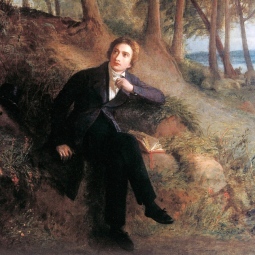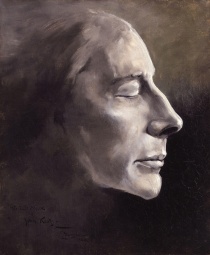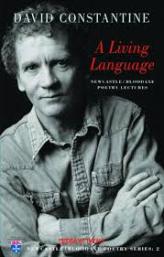Recently I went with some teaching colleagues to Keats House, London, to hear a discussion about the poet’s idea of Negative Capability and psychoanalysis. The speakers were Dr Margot Waddell, a child psychotherapist from the Tavistock Clinic, and Dr Toni Griffiths, Trustee of the Keats Foundation. Both were fascinating, condensing whole areas of scholarly knowledge into accessible (if intense) 45 minute talks. Waddell focused on the acknowledged influence of Keats’ idea on the work of psychoanalyst Wilfred Bion.
I’m not sure I feel very qualified to comment on that intriguing area without a good deal further reading, but a memorable phrase arose from it: Waddell argued that Bion saw the way that preconception obstructs perception and how this must adversely affect the therapist/patient relationship. Toni Griffiths’ elegant and economical discussion of Keats’ work (not merely the Negative Capability idea) set off several days of thought for me and has produced what I think will be two blog posts. Firstly, and perhaps largely for myself, I wanted to clarify my own understanding of Keats’ idea which has long meant a great deal to me. In my next post, I want to explain how those thoughts have “dove-tailed” (Keats’ own brilliant phrase in the Negative Capability letter to his brothers George and Tom, December 1817) with a recent translation of Yves Bonnefoy’s 1953 essay The Tombs of Ravenna (in the most recent PN Review (No. 226, Nov-Dec 2015, pp. 58-63).
This second blog is now available to be read here.
What follows below is my assemblage of observations from Keats’ letters, hopefully into a clear argument, indeed, into Keats’ coherent theory of poetic achievement and practice (though Negative Capability of course eschews all such systematizing). Page numbers in brackets are to John Keats: Selected Letters (Oxford World Classics, newly revised 2002).
In his 1817 letter to Benjamin Bailey, Keats wishes for “a Life of Sensations rather than of Thoughts!” (36). Just a year later, in a letter to James Hessey, he clarifies this distinction, suggesting that poetry is not “matured by law & precept, but by sensation and watchfulness” (146). The language use Keats associates with law and precept is evidently a fixed, a “preresolved” (303) language. What he seeks inits place is rather a language sufficiently flexuous and responsive to “watchfulness”, to attentiveness and often, when Keats discusses this, there is a strong sense of passivity. Writing to Bailey, characteristically using the phrase that an idea had “pressed upon” him (35), he says it has “increased my Humility and capability of submission”. The idea he is referring to is that artists (“Men of Genius”) “have not any individuality, any determined character”, as opposed to “Men of Power” who are replete and resolved in “a proper self” (35).
Keats’ distrust of such self-confident preresolution famously emerges in the 1818 letter to John Reynolds, as his dislike and distrust of poetry that has a “palpable design” on us (58) and to Bailey he contrasts this with an alertness to the “holiness of the heart’s affections and the truth of Imagination” (36/7). Preresolution pre-packages or pre-limits our emotional and spiritual life, whereas Keats is intent on welcoming “all”. This is what he means in the phrase “a Life of Sensations”, the latter word (rather misleadingly) encompassing both emotional and spiritual life as well as a full, open and alert response to the world about us. Such a full engagement with present experience is where we feel Imagination at work: Keats asks Bailey if he has not felt this in even such common experiences as listening to “an old Melody” and in the “elevation of the Moment” Keats declares we are “mounted on the Wings of Imagination” (37).
This ideal of a radical openness to present experience and its passive acceptance, was further clarified for Keats in his later dealings with his friend, Charles Dilke, who was becoming something of a political bore (spouting Godwinian philosophy and politics), a man who had resolved upon most issues. Keats again links this state to identity: Dilke is “a man who cannot feel he has a personal identity unless he has made his Mind up about every thing” (303). Dilke is one of the “stubborn arguers” who never begin upon any subject “they have not preresolved upon” (303). In contrast, Keats argues the only means of strengthening one’s intellect and identity “is to make up one’s mind about nothing – to let the mind be a thoroughfare for all thoughts” (303).
Keats’ best formulation of this idea arises when several things “dovetailed” in his mind after another frustrating debate with Dilke. The quality that marks out the artist – Shakespeare especially, he says – is Negative Capability. He defines this as consisting of a passive openness to the full range of human experience (“uncertainties, Mysteries, doubts”) without any imposition of preconceived notions, preresolved ideas or language: “without any irritable reaching after fact & reason” (41/2). Once again, the best way to understand this is through Keats’ word “watchfulness”, an attentiveness to the true nature of experiences. In yet another foray into these ideas, he experiments with the word “disinterestedness”. This again implies the absence of a forceful or dominating self, full of preconceived ideas, words, precepts. Writing to his brother George, he says “complete disinterestedness” is a difficult goal. He admits he is himself “far” from it though personally and in social terms he believes it “ought to be carried to its highest pitch” (213).
Such moments of disinterested perception occur in his observation of a sparrow picking about on the gravel (37). Approached with Negative Capability this mundane moment becomes something that “startles” and Keats says “I take part in its existince [sic]” (37). In this way, the poet is continually “filling some other body” (148). Such is the truth in a “Life of Sensations”, fuelled by Imagination, and one of the delights of a human life is that these happy moments will continue to be “repeated in a finer tone and so repeated”. The mind develops in this way through the repetition “of its own silent Working” (36). These refinements of the mind can occur only when experience is encountered openly, nakedly, even dangerously. To Reynolds, Keats wrote that to become fully “fit for this world”, with all its pains and hardship, a man would have to have “the fine point of his soul taken off” (39). But the poet or artist cannot afford to be so blunted by experiences but must remain radically open, even submissive to them. In the same letter to Reynolds, Keats quotes Shakespeare’s Venus and Adonis: “As the snail, whose tender horns being hit, / Shrinks back into his shelly cave with pain”. Such a reaction of withdrawal must not be countenanced by the would be artist. To Richard Woodhouse, Keats wrote “What shocks the virtuous philosopher, delights the camelion [sic] Poet” (148). The work of the poet experiences “no harm from its relish of the dark side of things any more than from its taste for the bright one” (148).
Keats recognizes and accepts the personal, experiential conclusion of such thoughts as he records his own sensation of feeling annihilated in a crowded room because “the identity of every one in the room begins to press upon me” (148). Yet this absence of a resolved self (pushing and barging over-confidently outwards) leaves room for such delicate encounters as that with the sparrow and on other occasions, catching a glimpse “of a stoat or fieldmouse peeping out of the withered grass – the creature hath a purpose and its eyes are bright with it” (213). Keats regards such escape from or evasion of this confinement to self as a form of purification: “there is an ellectric [sic] fire in human nature tending to purify” (213). He names Socrates and Jesus as perfections of this state, though “it is to be lamented that the history of the latter was written and revised by men interested in the pious fraud of Religion” (214). Of course, poetry must also aspire to this state and (as David Constantine has argued in his Bloodaxe lectures, A Living Language 2004)) Keats’ “gymnastics” in trying to broaden his native language-use (with its preresolutions) through a variety of foreign poetic experiments suggests he knew this well enough.
By the spring of 1819, Keats was further developing his ideas about the role and nature of the self with the letter discussing life as a “vale of Soul-making”. He dismisses naïve ideas of the “perfectibility” (232) of mankind, even doubting the real progress made by any “seldom appearing Socrates”. He jokes that fish are as likely to “philosophise the ice away from the Rivers” as man is likely to arrive at a perfect state because “the nature of the world will not admit it” (232). However much happiness a man can experience, there will still be worldly elements that “prey upon his nature”. It is from this conviction that Keats proposes – in stark contrast to any Christian reading of man’s life –the idea that we are born as intelligences (“sparks of the divinity” or “atoms of perception” (232)). Then through a system of “Spirit-creation”, the intelligence develops into a Soul by refining an individuality or identity. This process is an educative one, fuelled by Negative Capability, in that the world is allowed to impact fully on the human heart which is led to “feel and suffer in a thousand diverse ways” (233). Man can never achieve a state of perfection but as the world’s school of hard knocks is openly, vulnerably embraced so the process of individuation occurs via emotional experience. It follows that the human heart is “the teat from which the Mind or intelligence sucks its identity” (233). As various as the lives of all individuals are, so “various become their souls” since individual emotional experiences are the “fortifiers or alterers” of our ever-developing nature (234).
So Keats’ ideal poet must possess Negative Capability to fully experience the world before him without preresolution. Armed with sufficient language skills to express the plenitude of these experiences, the poet’s role is then to re-present them to the reader in such a way that the poem itself contributes to the reader’s own developing emotional life. The work of art is therefore an important contribution to the reader’s own on-going process of Spirit creation or individuation (though this is only going to occur if the reader too is possessed of Negative Capability and is not someone who opens a book of poems with firmly preresolved expectations and ideas).






Thank you Martyn (again) for such a thought-provoking summation. James
LikeLiked by 1 person
[…] evening (and those who experienced it as well), here is a review from Martyn Crucefix’s blog: https://martyncrucefix.com/2015/11/17/keats-negative-capability-clearly-explained/ Enjoy […]
LikeLiked by 1 person
Thanks for the link
LikeLike
[…] my last blog I was discussing Keats’ ideas about Negative Capability, provoked by a visit to Keats House and […]
LikeLike
[…] creative faculty to imagine that which we know”. This is succinctly put in Keats’ idea of Negative Capability, defined as a passive openness to the fullest range of human experience (“uncertainties, […]
LikeLike
[…] Moving from this particular to the general, it’s here that Lewis memorably declares “all reality is iconoclastic”. Our true acquaintance with reality or real presence is the only way to cleanse and scour our egotistical preconceptions whether of the dead or the living: “Not my idea of God, but God. Not my idea of H., but H. Yes, and also not my idea of my neighbour, but my neighbour”. In William Griffin’s hyper-episodic biography of Lewis, he reports a 1944 BBC broadcast given by Lewis in which he refers to Christians as “new men”, a new step in evolution. This is because they have abandoned their own personalities and allowed God to inhabit them. In looking for your self, Lewis argued, you find only hatred, loneliness, despair and rage. In turning away from the self we find “Him, and with Him everything else thrown in”. This is interesting as it’s a later (though ironically more traditional) version of Keats’ Godless explanation of the importance of negative capability (which I have discussed at length elsewhere). […]
LikeLike
[…] written elsewhere on this blog about the importance of Keats’ ideas for my own work and it powerfully struck me again, joining Amy and the other workshoppers in […]
LikeLike
[…] familiar with Keats’ ideas (expressed in his 1819 Letters) about the world as a ‘vale of soul-making’ will find something very familiar here. But […]
LikeLike